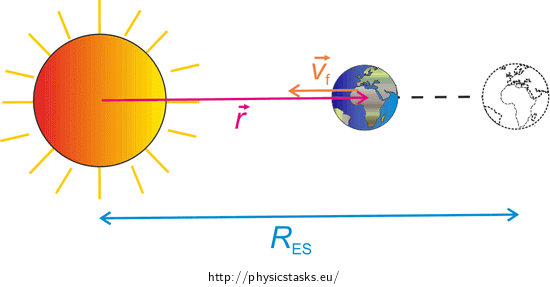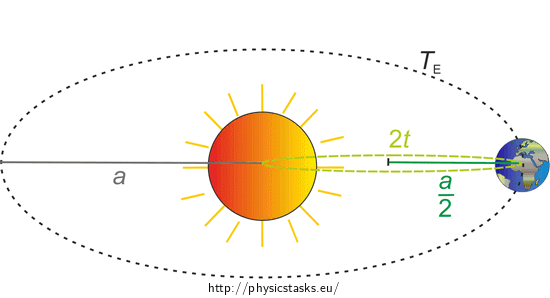Earth Falling Towards the Sun
Task number: 1760
How long would it take Earth to fall towards the Sun if Earth suddenly lost its orbital velocity?

Given values
\(v=0 \mathrm{\frac{km}{s}}\) orbital velocity of Earth \(t= ?\) time it takes Earth to fall towards the Sun Hint 1
Write the equation of motion of Earth using the law of conservation of energy.
Hint 2
How can we express the velocity \(v_{\mathrm{f}}\) by using distance \(r\) and time \(t\)?
Substitute this relationship for velocity \(v_{\mathrm{f}}\) into equation (5). How does the distance \(r\) change? Express time \(t\).
Hint 3
According to http://www.wolframalpha.com/ it is true that: \[\int{\sqrt{\frac{r}{R_{\mathrm{ES}}-r}}}\mathrm{d}r=\frac {\sqrt{\frac{r}{R_{\mathrm{ES}}-r}} \left(\sqrt{r} \left(r-R_{\mathrm{ES}} \right) + R_{\mathrm{ES}}\sqrt{R_{\mathrm{ES}}-r} \mathrm{arctg}\,{\sqrt{\frac{r}{R_{\mathrm{ES}}-r}}} \right) }{\sqrt {r}}+c,\] where \(c\) is a constant.
Use a derivative to verify this equality.
Hint 4
We verified that the following is true: \[\int{\sqrt{\frac{r}{R_{\mathrm{ES}}-r}}}\mathrm{d}r= -\sqrt{r\left(R_{\mathrm{ES}}-r\right)}+R_{\mathrm{ES}} \mathrm{arctg}\,{\sqrt{\frac{r}{R_{\mathrm{ES}}-r}}}+c.\] Use this relationship to determine time \(t\) from equation (6).
Overall solution
Equation of motion of Earth
The law of conservation of energy says that the sum of kinetic energy \(E_{\mathrm{k}}\) and potential energy \(E_{\mathrm{p}}\) is constant and is therefore equal to the initial energy of Earth \(E_{\mathrm{0}}\):
\[E_{\mathrm{k}}+E_{\mathrm{p}}=E_{\mathrm{0}}.\tag{1}\]Kinetic energy \(E_{\mathrm{k}}\) is equal to:
\[E_{\mathrm{k}}=\frac{1}{2}M_{\mathrm{E}}v_{\mathrm{f}}^2,\tag{2}\]where \(M_{\mathrm{E}}\) is the mass of Earth and \(v_{\mathrm{f}}\) is the magnitude of falling velocity of Earth at a given moment.

Potential energy \(E_{\mathrm{p}}\)of Earth at a distance \(r\) from the Sun is:
\[E_{\mathrm{p}}=-\kappa \frac{M_{\mathrm{E}}M_{\mathrm{S}}}{r},\tag{3}\]where \(\kappa\) is the gravitational constant and\(M_{\mathrm{S}}\) is the mass of the Sun.
Initial potential energy of Earth \(E_{\mathrm{0}}\) is equal to:
\[ E_{\mathrm{0}}=-\kappa \frac{M_{\mathrm{E}}M_{\mathrm{S}}}{R_{\mathrm{ES}}},\tag{4}\]where \(R_{\mathrm{ES}}\) is the distance of Earth from the Sun at the beginning of the fall, when Earth is not in motion.
By substituting equations (2), (3) and (4) into equation (1) we obtain the equation of motion:
\[\frac{1}{2}M_{\mathrm{E}}v_{\mathrm{f}}^2-\kappa \frac{M_{\mathrm{E}}M_{\mathrm{S}}}{r}=-\kappa \frac{M_{\mathrm{E}}M_{\mathrm{S}}}{R_{\mathrm{ES}}}.\]We divide both sides of the equation by \(M_{\mathrm{E}}\) and thus obtain:
\[\frac{1}{2}v_{\mathrm{f}}^2-\kappa \frac{M_{\mathrm{S}}}{r}=-\kappa \frac{M_{\mathrm{S}}}{R_{\mathrm{ES}}}.\tag{5}\]Evaluating velocity \(v_{f}\) and time \(t\)
The velocity \(v_{\mathrm{f}}\) can be expressed as a derivative of \(r\) with respect to \(t:\) \[v_{\mathrm{f}}=\frac{\mathrm{d}r}{\mathrm{d}t}.\]
By substituting this relationship into equation (5) we obtain:
\[\frac{1}{2}\left(\frac{\mathrm{d}r}{\mathrm{d}t}\right)^2-\kappa \frac{M_{\mathrm{S}}}{r}=-\kappa \frac{M_{\mathrm{S}}}{R_{\mathrm{ES}}}.\]We add \(\kappa \frac{M_{\mathrm{S}}}{r}\) to both sides of the equation:
\[\frac{1}{2}\left(\frac{\mathrm{d}r}{\mathrm{d}t}\right)^2=\kappa \frac{M_{\mathrm{S}}}{r}-\kappa \frac{M_{\mathrm{S}}}{R_{\mathrm{ES}}}.\]Now we multiply both sides by \(2\) and take the square root of both sides of the equation:
\[\left|\frac{\mathrm{d}r}{\mathrm{d}t}\right|=\sqrt{2\left(\kappa \frac{M_{\mathrm{S}}}{r}-\kappa \frac{M_{\mathrm{S}}}{R_{\mathrm{ES}}}\right)}.\]We factor \(\kappa M_{\mathrm{S}}\) out and we obtain:
\[\left|\frac{\mathrm{d}r}{\mathrm{d}t}\right|=\sqrt{2\kappa M_{\mathrm{S}}\left( \frac{1}{r} - \frac{1}{R_{\mathrm{ES}}} \right)}=\sqrt{2\kappa M_{\mathrm{S}}}\sqrt{ \frac{1}{r} - \frac{1}{R_{\mathrm{ES}}}}.\]Now we multiply both sides by \(\frac{\left|\mathrm{d}t\right|}{\sqrt{2\kappa M_{\mathrm{S}}}\sqrt{ \frac{1}{r} - \frac{1}{R_{\mathrm{ES}}}}}\) and swap the left and right side of the equation:
\[\left| \mathrm{d}t \right|=\frac{\left|\mathrm{d}r\right|}{\sqrt{2\kappa M_{\mathrm{S}}}\sqrt{ \frac{1}{r} - \frac{1}{R_{\mathrm{ES}}}}}.\]The distance \(r\) decreases with increasing time \(t\), so after removing the absolute value from our equation, we obtain
\[ \mathrm{d}t =\frac{-\mathrm{d}r}{\sqrt{2\kappa M_{\mathrm{S}}}\sqrt{ \frac{1}{r} - \frac{1}{R_{\mathrm{ES}}}}}.\]Now we have to integrate both sides of the equation:
\[t =\int_{R_{\mathrm{ES}}}^{R_{\mathrm{E}}+R_{\mathrm{S}}}{ \frac{-\mathrm{d}r}{\sqrt{2\kappa M_{\mathrm{S}}}\sqrt{ \frac{1}{r} - \frac{1}{R_{\mathrm{ES}}}}}},\]where \(R_{\mathrm{E}}\) is the radius of Earth and \(R_{\mathrm{S}}\) is the radius of the Sun.
At the beginning, \(r\) corresponds to the distance \(R_{\mathrm{ES}}\)and when Earth hits the Sun \(r\) is equal to the sum of the radius of Earth and the Sun \(R_{\mathrm{E}}+R_{\mathrm{S}}\). Therefore, the limits of the integral are \(R_{\mathrm{ES}}\) and \(R_{\mathrm{E}}+R_{\mathrm{S}}\).
We can swap limits and thus get rid of the minus sign before \(\mathrm{d}r\):
\[t =\int_{R_{\mathrm{E}}+R_{\mathrm{S}}}^{R_{ES}}{ \frac{\mathrm{d}r}{\sqrt{2\kappa M_{\mathrm{S}}}\sqrt{ \frac{1}{r} - \frac{1}{R_{\mathrm{ES}}}}}}.\]We factor out the constant \(\frac{1}{\sqrt{2\kappa M_{\mathrm{S}}}}\) from the integral:
\[t =\frac{1}{\sqrt{2\kappa M_{\mathrm{S}}}}\int_{R_{\mathrm{E}}+R_{\mathrm{S}}}^{R_{\mathrm{ES}}}{ \frac{\mathrm{d}r}{\sqrt{ \frac{1}{r} - \frac{1}{R_{\mathrm{ES}}}}}}.\]Inside the integral, we can find the common denominator of the terms under the square root ad adjust the fraction:
\[t =\frac{1}{\sqrt{2\kappa M_{\mathrm{S}}}}\int_{R_{\mathrm{E}}+R_{\mathrm{S}}}^{R_{\mathrm{ES}}}{\sqrt{\frac{rR_{\mathrm{ES}}}{R_{\mathrm{ES}}-r}}}\mathrm{d}r.\]We can factor out the constant \(\sqrt{R_{\mathrm{ES}}}\) from the integral:
\[t =\sqrt{\frac{R_{\mathrm{ES}}}{2\kappa M_{\mathrm{S}}}}\int_{R_{\mathrm{E}}+R_{\mathrm{S}}}^{R_{\mathrm{ES}}}{\sqrt{\frac{r}{R_{\mathrm{ES}}-r}}}\mathrm{d}r.\tag{6}\]Solving the integral \(\int{\sqrt{\frac{r}{R_{\mathrm{ES}}-r}}}\mathrm{d}r\)
According to http://www.wolframalpha.com/ it is true that:
\[\int{\sqrt{\frac{r}{R_{\mathrm{ES}}-r}}}\mathrm{d}r=\frac {\sqrt{\frac{r}{R_{\mathrm{ES}}-r}} \left(\sqrt{r} \left(r-R_{\mathrm{ES}} \right) + R_{\mathrm{ES}}\sqrt{R_{\mathrm{ES}}-r} \mathrm{arctg}\,{\sqrt{\frac{r}{R_{\mathrm{ES}}-r}}} \right) }{\sqrt {r}}+c,\]where \(c\) is a constant.
We use a derivative to verify this equality:
\[{\sqrt{\frac{r}{R_{\mathrm{ES}}-r}}}=\frac{\mathrm{d}}{\mathrm{d}r}\left(\frac {\sqrt{\frac{r}{R_{\mathrm{ES}}-r}} \left(\sqrt{r} \left(r-R_{\mathrm{ES}} \right) + R_{\mathrm{ES}}\sqrt{R_{\mathrm{ES}}-r} \mathrm{arctg}\,{\sqrt{\frac{r}{R_{\mathrm{ES}}-r}}} \right) }{\sqrt {r}}+c\right).\]Since \(\frac{\mathrm{d}c}{\mathrm{d}r}=0\) we obtain:
\[{\sqrt{\frac{r}{R_{\mathrm{ES}}-r}}}=\frac{\mathrm{d}}{\mathrm{d}r}\left(\frac {\sqrt{\frac{r}{R_{\mathrm{ES}}-r}} \left(\sqrt{r} \left(r-R_{\mathrm{ES}} \right) + R_{\mathrm{ES}}\sqrt{R_{\mathrm{ES}}-r} \mathrm{arctg}\,{\sqrt{\frac{r}{R_{\mathrm{ES}}-r}}} \right) }{\sqrt {r}}\right).\]We denote the left side of the equation by \(L\) and the right side by \(R\):
\[L={\sqrt{\frac{r}{R_\mathrm{ES}}-r}},\] \[R=\frac{\mathrm{d}}{\mathrm{d}r}\left(\frac {\sqrt{\frac{r}{R_{\mathrm{ES}}-r}} \left(\sqrt{r} \left(r-R_{\mathrm{ES}} \right) + R_{\mathrm{ES}}\sqrt{R_{\mathrm{ES}}-r} \mathrm{arctg}\,{\sqrt{\frac{r}{R_{\mathrm{ES}}-r}}} \right) }{\sqrt {r}}\right).\]We adjust the right side of the equation
\[R=\frac{\mathrm{d}}{\mathrm{d}r}\left( -\sqrt{r\left(R_{\mathrm{ES}}-r\right)}+R_{\mathrm{ES}} \mathrm{arctg}\,{\sqrt{\frac{r}{R_{\mathrm{ES}}-r}}}\right).\]We determine the derivative of the parenthesis:
\[R=-\frac{R_{\mathrm{ES}}-2r}{2\sqrt{r\left(R_{\mathrm{ES}}-r\right)}}+R_{\mathrm{ES}}\frac{1}{1+\frac{r}{R_{\mathrm{ES}}-r}}\cdot \frac{\frac{R_{\mathrm{ES}}-r-r\left(-1\right)}{\left(R_{\mathrm{ES}}-r \right)^2}}{2\sqrt{\frac{r}{R_{\mathrm{ES}}-r}}}.\]Now we adjust the expression:
\[R=\frac{2r-R_{\mathrm{ES}}}{2\sqrt{r}\sqrt{R_{\mathrm{ES}}-r}} +R_{\mathrm{ES}}\frac{1}{\frac{R_{\mathrm{ES}}-r+r}{R_{\mathrm{ES}}-r}}\cdot \frac{R_{\mathrm{ES}}\sqrt{R_{\mathrm{ES}}-r}}{2\sqrt{r}\left(R_{\mathrm{ES}}-r \right)^2},\] \[R=\frac{2r-R_{\mathrm{ES}}}{2\sqrt{r}\sqrt{R_{\mathrm{ES}}-r}} +\left(R_{\mathrm{ES}}-r\right)\cdot \frac{R_{\mathrm{ES}}\sqrt{R_{\mathrm{ES}}-r}}{2\sqrt{r}\left(R_{\mathrm{ES}}-r \right)^2},\] \[R=\frac{2r-R_{\mathrm{ES}}}{2\sqrt{r}\sqrt{R_{\mathrm{ES}}-r}} + \frac{R_{\mathrm{ES}}}{2\sqrt{r}\sqrt{R_{\mathrm{ES}}-r}}=\frac{2r}{2\sqrt{r}\sqrt{R_{\mathrm{ES}}-r}},\] \[R=\frac{\sqrt{r}}{\sqrt{R_{\mathrm{ES}}-r}}=\sqrt{\frac{r}{R_{\mathrm{ES}}-r}}.\]Thus \(L=R.\)
Determining \(t\)
We verified that this is true:
\[\int{\sqrt{\frac{r}{R_{\mathrm{ES}}-r}}}\mathrm{d}r= -\sqrt{r\left(R_{\mathrm{ES}}-r\right)}+R_{\mathrm{ES}} \mathrm{arctg}\,{\sqrt{\frac{r}{R_{\mathrm{ES}}-r}}}+c.\]We substitute the relationship derived above for the integral in relation (6):
\[t =\sqrt{\frac{R_{\mathrm{ES}}}{2\kappa M_{\mathrm{S}}}} \left[-\sqrt{r\left(R_{\mathrm{ES}}-r\right)}+R_{\mathrm{ES}} \mathrm{arctg}\,{\sqrt{\frac{r}{R_{\mathrm{ES}}-r}}}\right]_{R_{\mathrm{E}}+R_{\mathrm{S}}}^{R_{\mathrm{ES}}}.\]We substitute the limits of \(r\):
\(t =\sqrt{\frac{R_{\mathrm{ES}}}{2\kappa M_{\mathrm{S}}}} \left(-\sqrt{R_{\mathrm{ES}}\left(R_{\mathrm{ES}}-R_{\mathrm{ES}}\right)}+R_{\mathrm{ES}} \lim_{r \to {R_{\mathrm{ES}}}}\mathrm{arctg}\,{\sqrt{\frac{R_{\mathrm{ES}}}{R_{\mathrm{ES}}-r}}}\right) \)
\( -\sqrt{\frac{R_{\mathrm{ES}}}{2\kappa M_{\mathrm{S}}}}\left(-\sqrt{\left(R_{\mathrm{E}}+R_{\mathrm{S}}\right)\left(R_{\mathrm{ES}}-\left(R_{\mathrm{E}}+R_{\mathrm{S}}\right)\right)}+R_{\mathrm{ES}} \mathrm{arctg}\,{\sqrt{\frac{R_{\mathrm{E}}+R_{\mathrm{S}}}{R_{\mathrm{ES}}-\left(R_{\mathrm{E}}+R_{\mathrm{S}}\right)}}}\right) . \)
It applies \(\lim_{r \to {R_{\mathrm{ES}}}}\mathrm{arctg}\,{\sqrt{\frac{R_{\mathrm{ES}}}{R_{\mathrm{ES}}-r}}}= \frac{\pi}{2}\), \(\left(R_{\mathrm{ES}}-R_{\mathrm{ES}}\right)=0\), \(\left(R_{\mathrm{ES}}-\left(R_{\mathrm{E}}+R_{\mathrm{S}}\right)\right)=\left(R_{\mathrm{ES}}-R_{\mathrm{E}}-R_{\mathrm{S}}\right)\) and \(\sqrt{\frac{R_{\mathrm{ES}}}{2\kappa M_{\mathrm{S}}}}\) can be factored out. Thus, we obtain:
\(t =\sqrt{\frac{R_{\mathrm{ES}}}{2\kappa M_{\mathrm{S}}}} \left(R_{\mathrm{ES}}\frac{\pi}{2}+\sqrt{\left(R_{\mathrm{E}}+R_{\mathrm{S}}\right)\left(R_{\mathrm{ES}}-R_{\mathrm{E}}-R_{\mathrm{S}}\right)}-R_{\mathrm{ES}} \mathrm{arctg}\,{\sqrt{\frac{R_{\mathrm{E}}+R_{\mathrm{S}}}{R_{\mathrm{ES}}-R_{\mathrm{E}}-R_{\mathrm{S}}}}}\right). \)
Numerical solution
In The Handbook of Chemistry and Physics we look up the values for \(\kappa\), \(R_{\mathrm{E}}\), \(R_{\mathrm{S}}\), \(R_{\mathrm{ES}}\), \(M_{\mathrm{S}}\) and \(\pi\):
Gravitational constant: \(\kappa \dot= 6{.}67\cdot{10}^{-11} \mathrm{\frac{m^3}{kg\cdot s^2}}\).
Earth radius: \(R_{\mathrm{E}} \dot= 63{.}78\cdot{10}^{5} \mathrm{m}\).
Sun radius: \(R_{\mathrm{S}} \dot= 6{.}96\cdot{10}^{8} \mathrm{m}\).
Distance between Earth and the Sun: \(R_{\mathrm{ES}} \dot= 1{.}50\cdot{10}^{11} \mathrm{m}\).
Mass of the Sun: \(M_{\mathrm{S}} \dot= 1{.}99\cdot{10}^{30} \mathrm{kg}\).
Ludolf's number: \(\pi \dot= 3{.}14\).
By substituting we obtain: \(t \dot=23{.}77{\cdot} 10^{-6} \left(23{.}55{\cdot} 10^{10}+10{.}24{\cdot} 10^{9}-1{.}5{\cdot} 10^{11} \mathrm{arctg}\,{0{.}0686} \right) \mathrm{s} \dot= 5{.}6{\cdot} 10^{6} \mathrm{s}. \)
We convert the resulting value to whole days and obtain: \[ t \dot= 65 \mathrm{days}.\]
Answer
The time it would take Earth to fall to the Sun is: \(t =\sqrt{\frac{R_{\mathrm{ES}}}{2\kappa M_{\mathrm{S}}}} \left(R_{\mathrm{ES}}\frac{\pi}{2}+\sqrt{\left(R_{\mathrm{E}}+R_{\mathrm{S}}\right)\left(R_{\mathrm{ES}}-R_{\mathrm{E}}-R_{\mathrm{S}}\right)}-R_{\mathrm{ES}}\mathrm{arctg}\,{\sqrt{\frac{R_{\mathrm{E}}+R_{\mathrm{S}}}{R_{\mathrm{ES}}-R_{\mathrm{E}}-R_{\mathrm{S}}}}}\right). \)
Numerical solution: \(t \dot= 5{.}6{\cdot} 10^{6} \mathrm{s}. \)
We convert the resulting value to whole days and obtain: \[ t \dot= 65 \mathrm{days}.\]
Analysis of solution used at upper-secondary level
This task can be solved at an upper-secondary level by using Kepler's laws. We imagine that Earth travels closer to the Sun in a very narrow ellipse. When narrowing an ellipse, the foci move along the major axis towards the antipodal points of the ellipse. The Sun therefore lies at the centre of the original ellipse. Then we can use Kepler's third law to solve this task.
Hint 1 (Upper-secondary level)
Draw a picture of the Sun, Earth, the trajectory of Earth orbiting the Sun and trajectory of Earth that has lost its orbital velocity. Draw the trajectory of Earth that has lost its orbital velocity, as a narrow ellipse. In the picture, mark the lengths of the semi-major axes of the trajectories.
Hint 2 (Upper-secondary level)
Formulate Kepler's third law.
Hint 3 (Upper-secondary level)
Write Kepler's third law for the case of Earth orbiting the Sun and Earth falling towards the Sun. Evaluate the unknown time \(t\) of the fall.
Overall solution (Upper-secondary level)
Figure showing the trajectory of Earth orbiting the Sun and trajectory of Earth falling towards the Sun

\(T_{\mathrm{E}}\) is the period of revolution of Earth orbiting the Sun, and \(a\) is the semi-major axis of its trajectory.
\(2t\) is the period of revolution of Earth, which has lost its orbital velocity, and \(\frac{a}{2}\) is the major axis of its trajectory.
Kepler's third law
The ratio of squares of the orbital periods of two planets is equal to the ratio of lengths of the semi-major axes of their trajectories cubed.
Determining \(t\)
According to the picture (trajectory) and Kepler's third Law, we obtain:
\[\frac{\left(2t\right)^2}{T_{\mathrm{E}}^2}=\frac{\left(\frac{a}{2}\right)^3}{a^3}.\]We reduce the fraction on the right side and make the cube of \(\frac{1}{2}\):
\[\frac{\left(2t\right)^2}{T_{\mathrm{E}}^2}=\frac{1}{8}.\]We multiply both sides of the equation by \(\frac{T_{\mathrm{E}}^2}{4}\):
\[t^2=\frac{1}{8}\frac{T_{\mathrm{E}}^2}{4}.\]Finally, we make the square root of both sides of the equation and we obtain:
\[t=\sqrt{\frac{1}{8}}\frac{T_{\mathrm{E}}}{2}.\]Numerical solution:
We look up \(T_{\mathrm{E}}=365{.}26 \mathrm{d}\) in The Handbook of Chemistry and Physics and substitute this value into the equation:
\[t=\sqrt{\frac{1}{8}}\frac{365{.}26}{2} \mathrm{d} \dot= 64{.}57 \mathrm{d} \dot= 65 \mathrm{days}.\]Answer (Upper-secondary level)
The time it takes Earth to fall to the Sun is \(t=\sqrt{\frac{1}{8}}\frac{T_{\mathrm{E}}}{2}\).
Numerical solution: \(t \dot= 65 \mathrm{days}.\)


